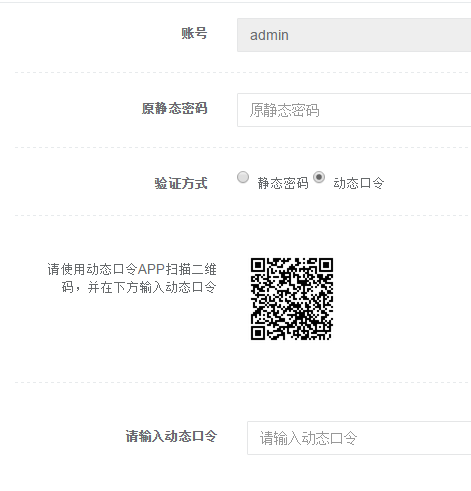大多数系统目前均使用的静态密码进行身份认证登录,但由于静态密码容易被窃取,其安全性无法满足安全要求。
动态口令采用一次一密、用过密码作废的方式防止了密码被窃取带来的安全问题。
动态口令分为HOTP(基于事件计数的动态口令,RFC4226)、TOTP(基于时间计数的动态口令,RFC6238)、OCRA(挑战应答式动态口令,RFC6287)等方式。
本文介绍了集成TOTP方式的动态口令认证的方案,PHP框架采用Thinkphp3.2.3,动态口令生成器使用的是google authtication。
1、为Thinkphp框架添加oath算法类
oath算法封装类oath.php代码如下:
<?PHP
/**
* This program is free software: you can redistribute it and/or modify
* it under the terms of the GNU General Public License as published by
* the Free Software Foundation, either version 3 of the License, or
* (at your option) any later version.
*
* This program is distributed in the hope that it will be useful,
* but WITHOUT ANY WARRANTY; without even the implied warranty of
* MERCHANTABILITY or FITNESS FOR A PARTICULAR PURPOSE. See the
* GNU General Public License for more details.
*
* You should have received a copy of the GNU General Public License
* along with this program. If not, see <http://www.gnu.org/licenses/>.
*
* PHP Google two-factor authentication module.
*
* See http://www.idontplaydarts.com/2011/07/google-totp-two-factor-authentication-for-php/
* for more details
*
* @author Phil
**/
class Google2FA {
const keyRegeneration = 30; // Interval between key regeneration
const otpLength = 6; // Length of the Token generated
private static $lut = array( // Lookup needed for Base32 encoding
"A" => 0, "B" => 1,
"C" => 2, "D" => 3,
"E" => 4, "F" => 5,
"G" => 6, "H" => 7,
"I" => 8, "J" => 9,
"K" => 10, "L" => 11,
"M" => 12, "N" => 13,
"O" => 14, "P" => 15,
"Q" => 16, "R" => 17,
"S" => 18, "T" => 19,
"U" => 20, "V" => 21,
"W" => 22, "X" => 23,
"Y" => 24, "Z" => 25,
"2" => 26, "3" => 27,
"4" => 28, "5" => 29,
"6" => 30, "7" => 31
);
/**
* Generates a 16 digit secret key in base32 format
* @return string
**/
public static function generate_secret_key($length = 16) {
$b32 = "234567QWERTYUIOPASDFGHJKLZXCVBNM";
$s = "";
for ($i = 0; $i < $length; $i++)
$s .= $b32[rand(0,31)];
return $s;
}
/**
* Returns the current Unix Timestamp devided by the keyRegeneration
* period.
* @return integer
**/
public static function get_timestamp() {
return floor(microtime(true)/self::keyRegeneration);
}
/**
* Decodes a base32 string into a binary string.
**/
public static function base32_decode($b32) {
$b32 = strtoupper($b32);
if (!preg_match('/^[ABCDEFGHIJKLMNOPQRSTUVWXYZ234567]+$/', $b32, $match))
throw new Exception('Invalid characters in the base32 string.');
$l = strlen($b32);
$n = 0;
$j = 0;
$binary = "";
for ($i = 0; $i < $l; $i++) {
$n = $n << 5; // Move buffer left by 5 to make room
$n = $n + self::$lut[$b32[$i]]; // Add value into buffer
$j = $j + 5; // Keep track of number of bits in buffer
if ($j >= 8) {
$j = $j - 8;
$binary .= chr(($n & (0xFF << $j)) >> $j);
}
}
return $binary;
}
/**
* Takes the secret key and the timestamp and returns the one time
* password.
*
* @param binary $key - Secret key in binary form.
* @param integer $counter - Timestamp as returned by get_timestamp.
* @return string
**/
public static function oath_hotp($key, $counter)
{
if (strlen($key) < 8)
throw new Exception('Secret key is too short. Must be at least 16 base 32 characters');
$bin_counter = pack('N*', 0) . pack('N*', $counter); // Counter must be 64-bit int
$hash = hash_hmac ('sha1', $bin_counter, $key, true);
return str_pad(self::oath_truncate($hash), self::otpLength, '0', STR_PAD_LEFT);
}
/**
* Verifys a user inputted key against the current timestamp. Checks $window
* keys either side of the timestamp.
*
* @param string $b32seed
* @param string $key - User specified key
* @param integer $window
* @param boolean $useTimeStamp
* @return boolean
**/
public static function verify_key($b32seed, $key, $window = 5, $useTimeStamp = true) {
$timeStamp = self::get_timestamp();
if ($useTimeStamp !== true) $timeStamp = (int)$useTimeStamp;
$binarySeed = self::base32_decode($b32seed);
for ($ts = $timeStamp - $window; $ts <= $timeStamp + $window; $ts++)
if (self::oath_hotp($binarySeed, $ts) == $key)
return true;
return false;
}
/**
* Extracts the OTP from the SHA1 hash.
* @param binary $hash
* @return integer
**/
public static function oath_truncate($hash)
{
$offset = ord($hash[19]) & 0xf;
return (
((ord($hash[$offset+0]) & 0x7f) << 24 ) |
((ord($hash[$offset+1]) & 0xff) << 16 ) |
((ord($hash[$offset+2]) & 0xff) << 8 ) |
(ord($hash[$offset+3]) & 0xff)
) % pow(10, self::otpLength);
}
}
/*
$InitalizationKey = "LFLFMU2SGVCUIUCZKBMEKRKLIQ"; // Set the inital key
$TimeStamp = Google2FA::get_timestamp();
$secretkey = Google2FA::base32_decode($InitalizationKey); // Decode it into binary
$otp = Google2FA::oath_hotp($secretkey, $TimeStamp); // Get current token
echo("Init key: $InitalizationKey\n");
echo("Timestamp: $TimeStamp\n");
echo("One time password: $otp\n");
// Use this to verify a key as it allows for some time drift.
$result = Google2FA::verify_key($InitalizationKey, "123456");
var_dump($result);
*/
?>由于google的动态口令算法中种子密钥使用了base32编码,因此需要base32算法,base32.php内容如下:
<?php
//namespace Base32;
/**
* Base32 encoder and decoder
*
* Last update: 2012-06-20
*
* RFC 4648 compliant
* @link http://www.ietf.org/rfc/rfc4648.txt
*
* Some groundwork based on this class
* https://github.com/NTICompass/PHP-Base32
*
* @author Christian Riesen <chris.riesen@gmail.com>
* @link http://christianriesen.com
* @license MIT License see LICENSE file
*/
class Base32
{
/**
* Alphabet for encoding and decoding base32
*
* @var array
*/
private static $alphabet = 'ABCDEFGHIJKLMNOPQRSTUVWXYZ234567=';
/**
* Creates an array from a binary string into a given chunk size
*
* @param string $binaryString String to chunk
* @param integer $bits Number of bits per chunk
* @return array
*/
private static function chunk($binaryString, $bits)
{
$binaryString = chunk_split($binaryString, $bits, ' ');
if (substr($binaryString, (strlen($binaryString)) - 1) == ' ') {
$binaryString = substr($binaryString, 0, strlen($binaryString)-1);
}
return explode(' ', $binaryString);
}
/**
* Encodes into base32
*
* @param string $string Clear text string
* @return string Base32 encoded string
*/
public static function encode($string)
{
if (strlen($string) == 0) {
// Gives an empty string
return '';
}
// Convert string to binary
$binaryString = '';
foreach (str_split($string) as $s) {
// Return each character as an 8-bit binary string
$binaryString .= sprintf('%08b', ord($s));
}
// Break into 5-bit chunks, then break that into an array
$binaryArray = self::chunk($binaryString, 5);
// Pad array to be divisible by 8
while (count($binaryArray) % 8 !== 0) {
$binaryArray[] = null;
}
$base32String = '';
// Encode in base32
foreach ($binaryArray as $bin) {
$char = 32;
if (!is_null($bin)) {
// Pad the binary strings
$bin = str_pad($bin, 5, 0, STR_PAD_RIGHT);
$char = bindec($bin);
}
// Base32 character
$base32String .= self::$alphabet[$char];
}
return $base32String;
}
/**
* Decodes base32
*
* @param string $base32String Base32 encoded string
* @return string Clear text string
*/
public static function decode($base32String)
{
// Only work in upper cases
$base32String = strtoupper($base32String);
// Remove anything that is not base32 alphabet
$pattern = '/[^A-Z2-7]/';
$base32String = preg_replace($pattern, '', $base32String);
if (strlen($base32String) == 0) {
// Gives an empty string
return '';
}
$base32Array = str_split($base32String);
$string = '';
foreach ($base32Array as $str) {
$char = strpos(self::$alphabet, $str);
// Ignore the padding character
if ($char !== 32) {
$string .= sprintf('%05b', $char);
}
}
while (strlen($string) %8 !== 0) {
$string = substr($string, 0, strlen($string)-1);
}
$binaryArray = self::chunk($string, 8);
$realString = '';
foreach ($binaryArray as $bin) {
// Pad each value to 8 bits
$bin = str_pad($bin, 8, 0, STR_PAD_RIGHT);
// Convert binary strings to ASCII
$realString .= chr(bindec($bin));
}
return $realString;
}
}
?>将这两个文件放到Thinkphp框架的ThinkPHP\Library\Vendor\oath目录下,oath目录是自己创建的。
2、添加数据库字段
用户表添加如下字段:
auth_type(0-静态密码,1-动态口令)
seed(种子密钥)
temp_seed(临时种子密钥)
last_logintime(上次登录成功时间)
last_otp(上次使用密码)
其中auth_type是为了标明用户使用的哪种认证方式,seed为用户的种子密钥,temp_seed为用户未开通前临时保存的一个种子密钥,如果用户开通动态口令认证成功,该字段内容会填到seed字段。last_logintime和last_otp为上次认证成功的时间和动态口令,用于避免用户同一个口令重复使用。
3、代码集成
1、开通动态口令
在原有系统的修改密码页面,加上认证方式的选择,例如:

如果用户选择动态口令方式,则会生成一张二维码显示在页面,用于用户开通动态口令。为了兼容google authtication,其二维码格式与谷歌一样。生成二维码的方法见我的另一篇博客《Thinkphp整合phpqrcode生成二维码》。
生成密钥二维码代码如下:
public function qrcode()
{
Vendor('oath.base32');
$base32 = new \Base32();
$rand = random(16);//生成随机种子
$rand = $base32->encode($rand);
$rand=str_replace('=','',$rand);//去除填充的‘=’
$errorCorrectionLevel =intval(3) ;//容错级别
$matrixPointSize = intval(8);//生成图片大小
//生成二维码图片
Vendor('phpqrcode.phpqrcode');
$object = new \QRcode();
$text = sprintf("otpauth://totp/%s?secret=%s", $user, $rand);
$object->png($text, false, $errorCorrectionLevel, $matrixPointSize, 2);
生成的种子$rand保存到数据库的temp_seed字段
}random是生成随机字符串函数。$rand=str_replace('=','',$rand)这句代码是因为谷歌手机令牌中base32解码算法并没有填充的‘=’号。
验证用户动态口令的代码如下:
从数据库读取temp_seed
Vendor('oath.oath');
$object = new \Google2FA();
if($object->verify_key($temp_seed, $otp)){
验证成功,将数据库更新seed为temp_seed,auth_type为1,last_otp为otp
}2、动态口令登录
用户动态口令登录验证的代码:
从数据库读取auth_type,seed,last_otp字段。
if($auth_type==1){//动态口令
//防止重复认证
if($lat_otp == $otp) {
动态口令重复使用返回
}
Vendor('oath.oath');
$object = new \Google2FA();
if(!$object->verify_key($seed, $otp))
{
动态口令不正确
}
else
{
登录成功,将数据库更新last_otp为$otp,last_logintime为time()
}
}4、测试验证
下载google authtication,使用静态密码登录系统,进入修改密码页面。
打开google authtication,扫描二维码,会显示动态口令。

保存内容,开通动态口令成功!
然后你就可以用高大上的动态口令登录系统了!


























 624
624

 被折叠的 条评论
为什么被折叠?
被折叠的 条评论
为什么被折叠?








